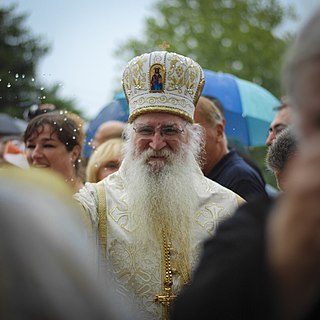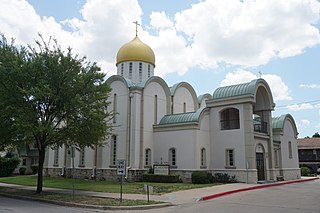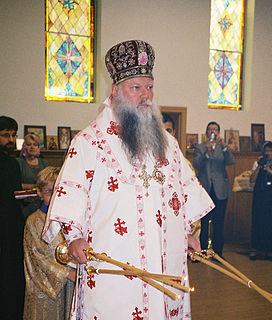Related Research Articles

Seraphim Rose, also known as Seraphim of Platina, was an American hieromonk of the Russian Orthodox Church Outside Russia who co-founded the St. Herman of Alaska Monastery in Platina, California. He translated Orthodox Christian texts and authored several works. His writings have been credited with helping to spread Eastern Orthodox Christianity throughout the West; his popularity equally extended to Russia itself, where his works were secretly reproduced and distributed by samizdat during the Communist era, remaining popular today.

Saint John of Shanghai and San Francisco, was a prominent Eastern Orthodox ascetic and hierarch of the Russian Orthodox Church Outside Russia (ROCOR) who was active in the mid-20th century. He was a pastor and spiritual father of high reputation and a reputed wonderworker to whom were attributed powers of prophecy, clairvoyance and healing. He is often referred to as "St. John the Wonderworker".

Western Rite Orthodoxy, also called Western Orthodoxy or the Orthodox Western Rite, are congregations within the autocephalous churches of Eastern and Oriental Orthodoxy which perform their liturgy in Western forms.
The timeline of Eastern Orthodoxy in North America represents timeline of the historical development of religious communities, institutions and organizations of Eastern Orthodox Christianity in North America.

Eastern Orthodox Christianity in Hawaii began with early Russian missions of the 19th century and continues with multiple Eastern Orthodox churches in the Hawaiian islands.

Holy Trinity Monastery is a male stavropegial monastery of the Russian Orthodox Church Outside of Russia (ROCOR), located near Jordanville, New York. Founded in 1930 by two Russian immigrants, it eventually became a main spiritual center of Russian Orthodoxy in the West. The monastery is well known for its publishing work and for the attached Holy Trinity Orthodox Seminary, which has educated many clergymen in ROCOR and other Orthodox jurisdictions. Due to their closeness to the hamlet, both the monastery and seminary are often simply referred to as Jordanville. The monastery is dedicated to the Holy Trinity, and its patronal feast day is Pentecost. The campus includes a museum that is open to the public.

Eastern Orthodox Christianity in Thailand has been represented since 1999 by the Representative Office of the Russian Orthodox Church, including the orthodox parish of Saint Nicolas in Bangkok.

Metropolitan Jonah is a retired American Eastern Orthodox bishop who served as the primate of the Orthodox Church in America (OCA) with the title The Most Blessed Archbishop of Washington, Metropolitan of All America and Canada from his election on November 12, 2008, until his resignation on July 7, 2012. Metropolitan Jonah was the first convert to the Orthodox faith to have been elected as the primate of the OCA.

The Diocese of Great Britain and Western Europe is a diocese of the Russian Orthodox Church Outside Russia (ROCOR), encompassing all of western Europe but with communities primarily on territories of the United Kingdom, Switzerland and France.

November 26 - Eastern Orthodox liturgical calendar - November 28
Russian settlement in the Philippines began when Russians from China who were escaping Communist rule left the country and settled in the Philippines.

Jerome Shaw, born John Robert Shaw and commonly known as Bishop Jerome, is a retired bishop of the Russian Orthodox Church Outside of Russia. He was formerly the auxiliary bishop of Manhattan. He is a Slavist, theologian and polyglot, adherent of the Western Rite Orthodoxy.

Bishop George is bishop of the Russian Orthodox Church Outside of Russia, bishop of Canberra, vicar of the Australian and New Zealand Diocese, and former abbot of the Holy Cross Monastery in Wayne, West Virginia.
Eastern Orthodoxy in Pakistan is a Christian denomination in the country of Pakistan. In 2011, the number of Eastern Orthodox Christians in Pakistan was estimated at 500 people. The present population of Orthodox Christians in Pakistan is around 3,000. It represents approximately 0.0002% of the population. Eastern Orthodox churches in the country are represented by the Patriarchate of Constantinople, the Patriarchate of Moscow and the Russian Orthodox Church Outside Russia (ROCOR) The five Eastern Orthodox parishes are Parish of Constantinople Patriarchate (Wazirabad), Parish of the Russian Orthodox Church (MP) (Lahore) Community of the Russian Orthodox Church (MP) (Islamabad), Russian Orthodox Church Outside Russia (ROCOR) (Sargodha) and Rahimyarkhan, Faisalabad and Rawalpindi Islamabad.

Saint Seraphim Cathedral, located near downtown Dallas, Texas, is the primary episcopal seat of the Diocese of the South, sharing its status with Christ the Saviour (Orthodox) Cathedral in Miami Lakes, Florida. The namesake of the Cathedral is Saint Seraphim of Sarov.

Archbishop Peter is ruling bishop of the Russian Orthodox Church Outside of Russia, archbishop of Chicago and Mid-America.

Archimandrite Roman is Archimandrite of the Russian Orthodox Church Outside Russia and current chief of the ROCOR Russian Ecclesiastical Mission in Jerusalem.

The Diocese of the Philippines and Vietnam is a diocese of the Patriarchate of Moscow created on 26 February 2019, directly under the Patriarchal Exarchate in Southeast Asia (PESEA).